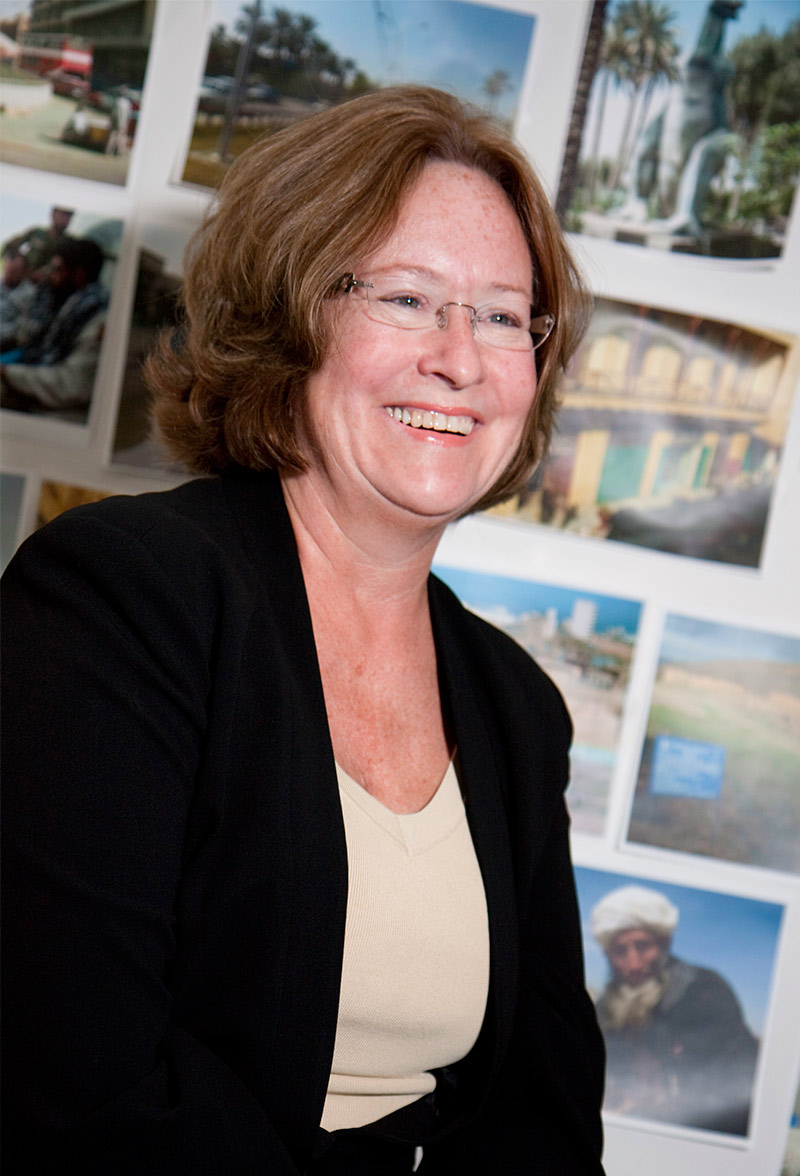
Dr. Marjorie Zielke
A professor in the School of Arts, Technology, and Emerging Communication is researching the development of a virtual teacher that will facilitate the most demanding portions of learning curricula for children with dyslexia.
Dr. Marjorie Zielke, who is also director of UT Dallas’ Center for Modeling and Simulation, and her team are collaborating with the Luke Waites Center for Dyslexia and Learning Disorders at Texas Scottish Rite Hospital for Children (TSRHC) to create the simulation.
“For several compelling reasons, we are researching a virtual teacher,” said Zielke, director of ATEC’s Virtual Humans and Synthetic Societies Lab. “The challenge is that there aren’t enough trained therapists for some of the most challenging portions of the hospital’s dyslexia curriculum termed ‘new learning.’ We’re researching a variety of technology approaches to fill this gap.”
According to TSRHC, dyslexia is a learning disorder that affects approximately 10 percent of children. Those diagnosed with dyslexia have trouble connecting sounds to letter symbols. This affects the way children with dyslexia learn to read and spell.
Dr. Jeffrey Black, medical director of the Luke Waites Center, looks forward to implementing this new technology-based system.
“The center has had success using technology in the form of recorded teaching paired with teacher-facilitated learning in helping the child with dyslexia to read and spell,” Black said. “Advances in the understanding of dyslexia treatment and the development of interactive technology-driven instruction make this the right time for the next TSRHC curriculum innovation. Making effective intervention accessible to more students is the goal.”
Zielke said several components of the technology development will provide excellent research opportunities for the Sim Center team.
The interface under consideration for the project will include the live teacher, the students and the virtual teacher, among other technologies the team is considering.
“The interaction between this triad is a design challenge,” Zielke said. “The persona of the virtual teacher is another research design component, and we are studying several model therapists to create the right visualization, voice and personality for the potential virtual teacher.”
“One important aspect of this virtual teacher research is that the curriculum and the content is critical, but we also must consider everything a therapist does. In this particular project, we are studying the back-and-forth interaction between the students and the virtual teacher. The children have to enjoy the experience and understand what they’re supposed to learn.”
Dr. Marjorie Zielke,
assistant professor of arts and technology and director of UT Dallas’ Center for Modeling and Simulation
Researchers also must immerse themselves into the subject matter to understand the program fully. She said researchers must consider elements such as vocalization and human physiology.
“An important part of what we do is collaborating with subject matter experts,” Zielke said. “We need to be able to work really closely with them. A big part of the project is the collaborative design phase, so we’ve been studying videos of live lessons and analyzing them as well.”
One of the main challenges in the initial design phase is making the tradeoff between the live teacher and the simulation seamless.
“One important aspect of this virtual teacher research is that the curriculum and the content is critical, but we also must consider everything a therapist does,” she said. ‘In this particular project, we are studying the back-and-forth interaction between the students and the virtual teacher. The children have to enjoy the experience and understand what they’re supposed to learn.”
Zielke sees the potential for incorporating new technology like the Oculus Rift, a virtual reality head-mounted display, into future projects.
Although she’s not considering these technologies for the dyslexia project, Zielke said she has expanded her research focus from screen-based environments to virtual reality to better represent face-to-face interactions.
“We don’t really focus on one particular technology, but rather we try to consider the research objective,” she said. “In fact, an important area of research and a question we are frequently asked is, ‘How do various media work together to create the holistic curriculum?’”
The Sim Center team has enjoyed recent successes in health education-related simulations.
In 2015, the team won Best in Show: Academic Faculty or Staff Category in the peer-reviewed Serious Games and Virtual Environments Competition at the International Meeting for Simulation in Healthcare. It was honored for its work on the TIME (Transformation in Medical Education) Learning Portal — an internally funded project done in collaboration with UT Southwestern Medical Center.
The team also won the same award in 2014 for GLIMPSE — A Game to Learn Important Communications Methods for Patient Safety Enhancement — which simulates communication between physicians and nurses. The project was a collaboration with UT Arlington’s College of Nursing and Health Innovation, and Baylor Scott & White Health. It was funded by the Agency for Healthcare Research and Quality through UT Arlington.
Zielke recalled some of the research design issues in some of her team’s earlier projects, such as GLIMPSE.
She said the medical component of the dialogue has to be precise because researchers are portraying behavior in the context of the medical profession. Audiences lose interest if they encounter unrealistic situations in games, but her team must simultaneously try to persuade users to adopt these new communication strategies.
“In the case of the project with TSRHC, the design is very deliberate in terms of what has to happen,” she said. “The curriculum is complicated for therapists to learn. By creating a virtual therapist and considering other technology solutions, we can potentially have educational programs more widely available to children because there will be more resources to help teach.”